
The climate challenge confronts America
Three chapters in a story of hard-won progress
An inconvenient truth
There’s no sugar-coating it: America and the rest of the world are not doing enough, nor are we doing it fast enough to slow global warming.
It’s also no wonder. Climate advocates and activists are rightly calling for wholesale change in how we power our lives, with the attendant disruption of major industries that hold enormous political influence, in a time when misinformation flies far faster around the internet than the truth. If fossil fuel money and power didn’t exist, the challenge would still be among the greatest human civilization has ever faced. Against that money, power and the misinformation they enable, winning the race against climate catastrophe is the longest of long shots.
It don’t come easy
Yet progress is progress, and our network is proud to have played our part in the larger story of hard-won progress on climate, including:
Clean Car standards in 14 states that have accelerated the reduction in motor vehicle carbon emissions and the electrification of transportation.
Power plant pollution limits throughout the Northeast and Mid-Atlantic that have helped America reduce how much coal and oil it burns to generate.
Hearts and minds won for climate action, including a landslide victory in a 2010 California referendum.
Only a fool would measure this progress as adequate. Emissions, temperatures and seas are still rising. Wildfires, droughts and storms are still more frequent, dangerous and deadly.
The pace of progress is never fast enough, especially when the consequences are so enormous. But there are no shortcuts. Our campaigns for progress in decarbonizing our world in ways that are significant, popular and durable go on.
Video credits: Flooding, New Jersey, 2021, Benjamin Clapp; Dixie Fire, California, 2021, Rick Ray; Hurricane Ida, 2021, Cinematic Storm Footage; all via Shutterstock

A historic moment on climate
It’s May 19, 2009. President Obama strides up to the podium in the Rose Garden and makes history, announcing the first-ever federal limits on the heat-trapping, climate-disrupting pollution that travels from the tailpipes of our cars and trucks into the Earth’s atmosphere.
As the president and other speakers detail what the limits will accomplish — a reduction in carbon emissions of 900 million metric tons, the equivalent of removing 177 million cars from the roads or shutting down 94 coal-fired power plants — he is surrounded not only by elected and appointed officials and environmental advocates (including Environment America’s Emily Figdor), but also by past opponents of such standards: the leaders of the American auto industry.
It’s a defining moment, one that has been at least a decade in the making, with the staff and members of PIRG, Environment America and the state environmental groups often in the center of the action.
California set the standard
Nearly five years before President Obama announced his groundbreaking action on climate, environmental officials in California began to pave the way.
On Sept. 24, 2004, California adopted the first state-level set limits on tailpipe carbon pollution. Before the decision, our staff and volunteers gathered 100,000 petition signatures in support of the action.
The move posed a challenge to the auto industry: Not only did California account for more than one tenth of all vehicles in the U.S., but seven other states (starting with Massachusetts in 1990) had previously indicated they would follow California’s lead — bringing the total to more than a quarter of the nation's vehicles. The industry could either fight the new standard or start retooling for a future that could soon prove inevitable. They decided to fight … for the time being.
Throughout the 1990s and 2000s, the PIRGs in California, Massachusetts and other states were instrumental in the adoption of Clean Car standards (aka Low-Emission Vehicle or LEV standards) for smog-forming and other pollutants that were stronger than the federal rules. And when California set a new bar by limiting carbon pollution, NJPIRG’s advocacy led New Jersey to become the next state to adopt the same carbon-reducing standard.
14 states (and counting) in a race to the top
By 2009, 14 states representing 35% of the nation's vehicle market had adopted California’s tougher auto standards, granting President Obama and then-Vice President Biden enormous leverage in negotiating with the auto companies over new federal standards.
As Politico reported in 2009, “Auto manufacturers have fought past attempts to raise mileage standards, but came to the table this time out of fears of [a] patchwork of national standards — particularly because California has been trying to create a more aggressive benchmark for decreasing greenhouse gases.”
Our staff and members spurred California to get more aggressive and helped create that national patchwork, by successfully urging adoption of California’s tough emission standards in New Jersey, Massachusetts, Maryland, Colorado, Pennsylvania and other states.
While the Trump administration sought to roll back the Obama Clean Car standards, it never fully succeeded, thanks again in part to our advocacy and litigation. Meanwhile, on Sept. 23, 2020, California Gov. Gavin Newsom announced that by 2035, all new cars and trucks sold in his state would be zero-emission vehicles. On Jan. 5, 2021, Massachusetts Gov. Charlie Baker made the same commitment.
Zero-carbon transportation, an idea that seemed fanciful not so long ago, is suddenly and increasingly within reach.
Photo: Scharfsinn via Shutterstock

A U.S. PIRG organizer and advocate Rebecca Stanfield deliver petitions on clean car standards. By staff
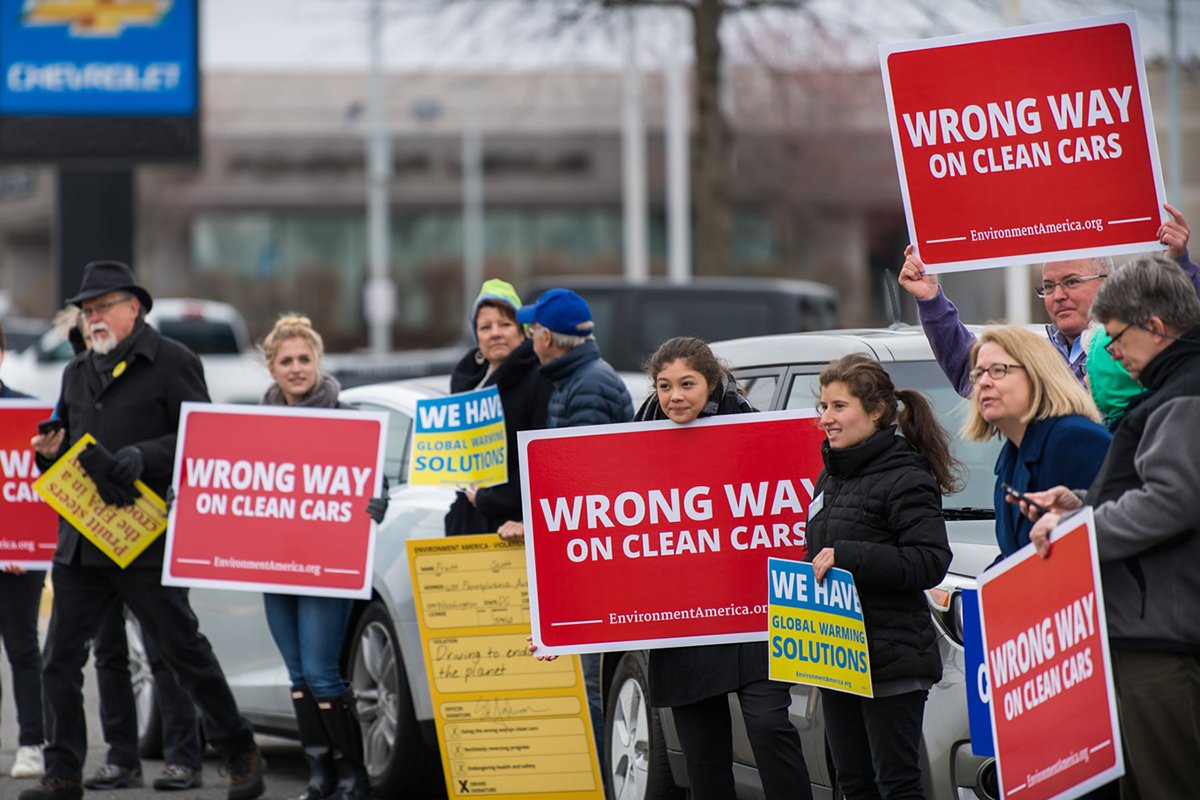
Environment America members protest the EPA’s rollback of car emission standards in 2018. Photo by TJ O'Neill, TJO Photography
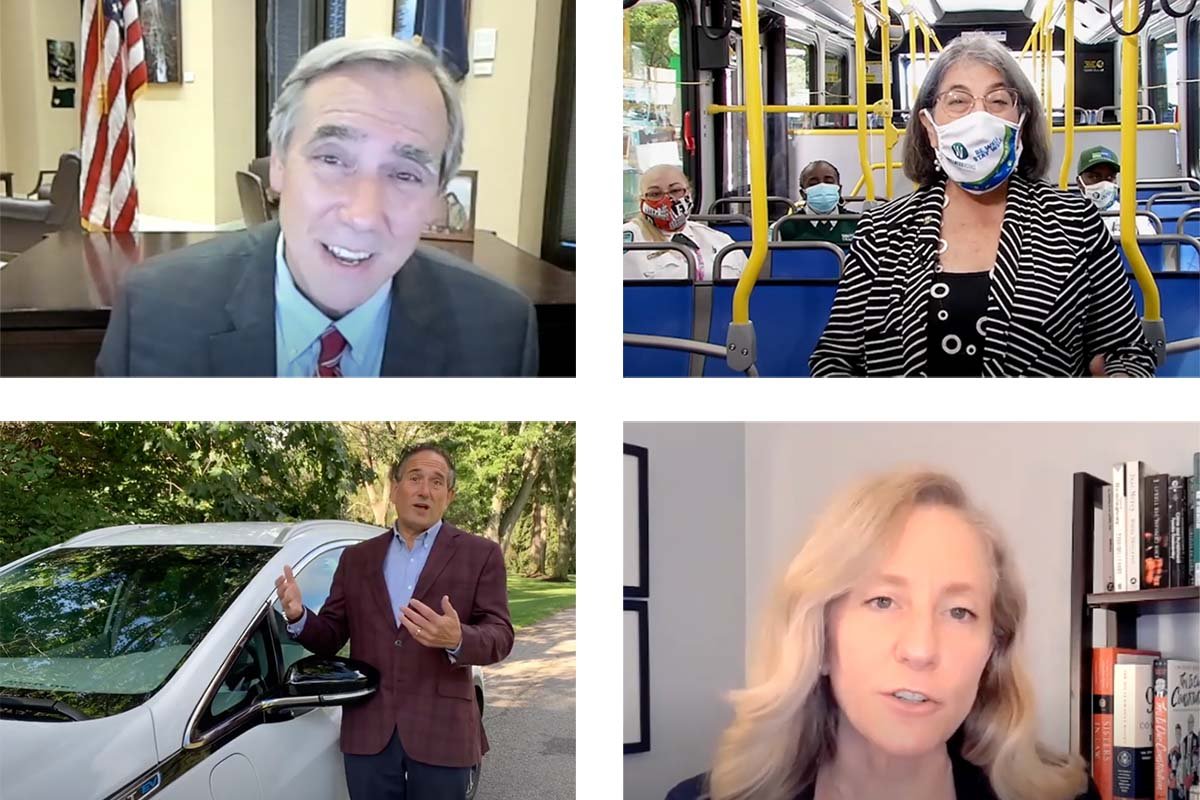
Stills from Environment America's EV Week video. Clockwise: Sen. Jeff Merkley, Miami-Dade Mayor Daniella Levine Cava, Rep. Abigail Spanberger, Rep. Andy Levin.
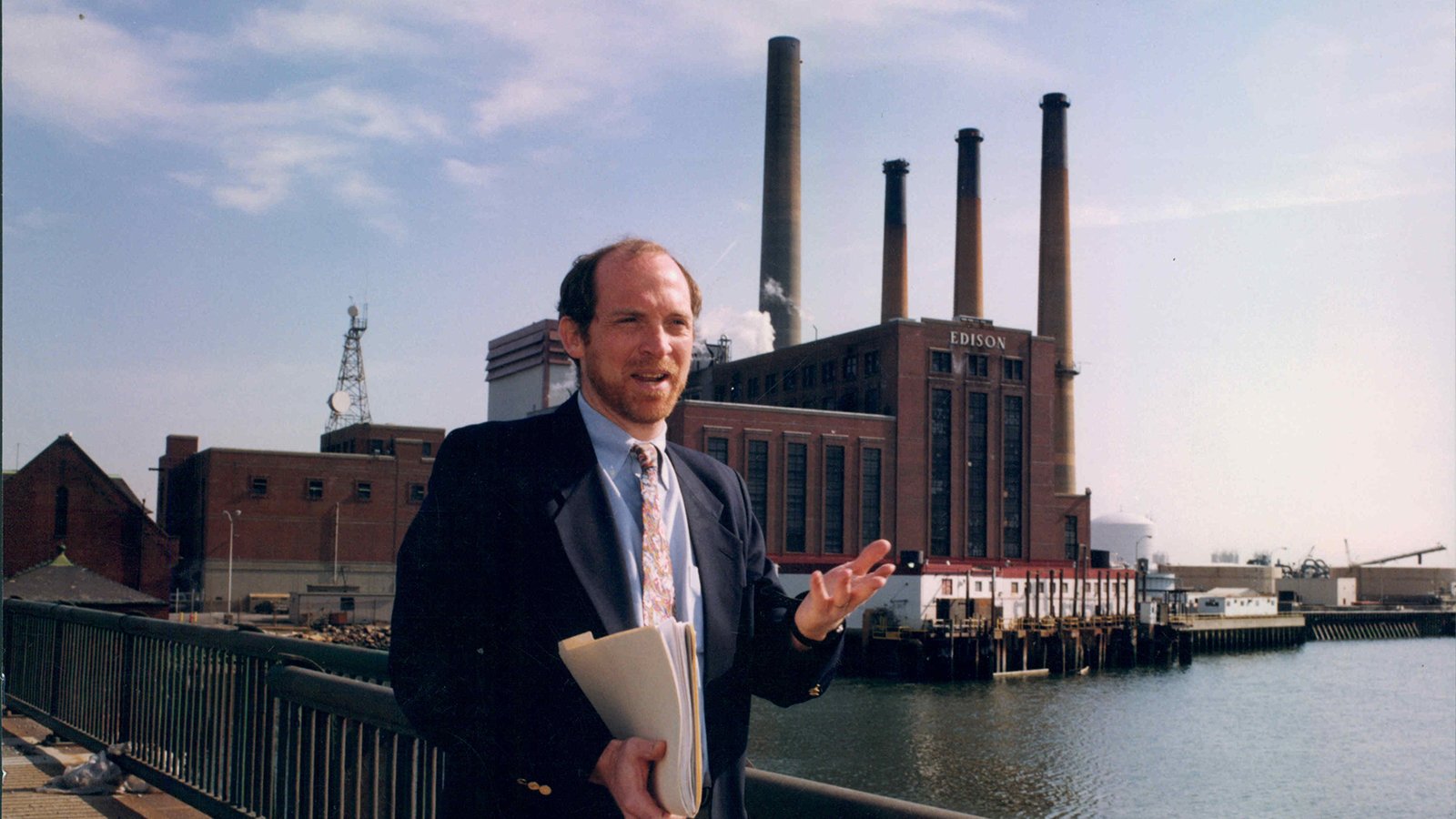
A turning point in power plant pollution
The findings of a February 26, 2018, report are remarkable: In a little more than a decade, nine states have cut the amount of carbon dioxide emitted from their electricity-generating power plants in half. A subsequent study finds this progress outpaces the rest of the nation by 90%.
What went right?
The answer starts in 1997. In that year, MASSPIRG and Community Action Works (then called Toxics Action Center), along with other members of the Clean Air Now coalition, join forces to rein in pollution from New England power plants, which have escaped modern emission limits due to a loophole in the Clean Air Act. The coalition decides to focus on power plants’ role in four types of pollution: smog, soot, mercury and global warming.
The decision to call for limits on planet-warming carbon dioxide emissions is a bold one: At this time, there are no state or federal limits on these emissions. None.
A call to clean up the ‘Filthy Five’
The first breakthrough in the power plant campaign comes in Massachusetts.
Five of the country’s oldest and dirtiest plants produce much of the state’s global warming pollution. MASSPIRG’s Rob Sargent dubs them the “Filthy Five” and, together with Clean Water Action and dozens of local groups, calls on the state to clean them up or shut them down.
In the fall of 1998, Rob discovers that state law allows any citizen to petition a state agency to adopt a regulation and compel the agency to respond. MASSPIRG files a petition urging the Department of Environmental Protection to set tough pollution limits for the Filthy Five. On Oct. 1 of the same year, Gov. Cellucci signs a pledge to do just that. On April 23, 2001, after MASSPIRG and our allies help turn out 1,000 citizens to public hearings, Gov. Jane Swift (who succeeds Gov. Cellucci after he is appointed ambassador to Canada) fulfills his pledge — making Massachusetts the first in the nation to limit carbon (and mercury) emissions from power plants.
By 2017, the Filthy Five power plants are all shut down. A solar farm sits atop the site of one coal-fired plant in Holyoke, Mass. An offshore wind facility is proposed for another, in Salem.
‘Come back stronger’
In Connecticut, as part of their Green Corps training program, Bernadette Del Chiaro and Merc Pittinos are assigned to build public support for a bill to clean up the state’s Sooty Six power plants. (Cindy Kang, then a Yale student, also joins the Sooty Six campaign as a volunteer, and later becomes Green Corps executive director from 2008 to 2012.)
Year after year after year, the campaign builds support but falls short. Undaunted, the campaign team vows that “If we lose, we lose big and come back stronger.” Finally, in 2002 Gov. John Rowland signs the first law in the country to limit power plant carbon pollution.
The best climate program you’ve never
heard of
By 2003, as similar PIRG-led campaigns to clean up power plant carbon emissions are making inroads in other Northeastern states, New York Gov. George Pataki invites the region’s other governors to discuss a joint program to curb their pollution.
In 2005, the governors create the Regional Greenhouse Gas Initiative (RGGI), the nation’s first carbon cap-and-trade program, requiring power plants to pay for their pollution and reinvesting the money in clean energy.
Seven states sign up in 2005. In 2007, three more (Maryland, Massachusetts and Rhode Island) join; in 2020, New Jersey rejoins (after leaving under Gov. Chris Christie) and Virginia signs up; Pennsylvania is on track to join in 2022. In each case, states join or rejoin after PIRG or our state environmental groups urge them to do so.
RGGI becomes a driving force in reducing power plant emissions and, through its clean energy investments, saves consumers nearly $400 million on their power bills.
In 2015, following advocacy and organizing by Environment America, the U.S. EPA announces a federal plan to limit climate pollution from electricity generation across the country. The plan is challenged in court and by the Trump administration. But the writing is on the wall: generating power by warming the climate is coming at an increasingly high cost that even many utilities are no longer willing to pay.

Toxics Action Center’s Bernadette Del Chiaro and Alyssa Schuren stand with Connecticut residents who worked on the Sooty Six campaign. By staff

Environment New Jersey’s Dena Mattola Jaborska speaks at a lobby day event in Trenton. Photo by Galuppo Productions
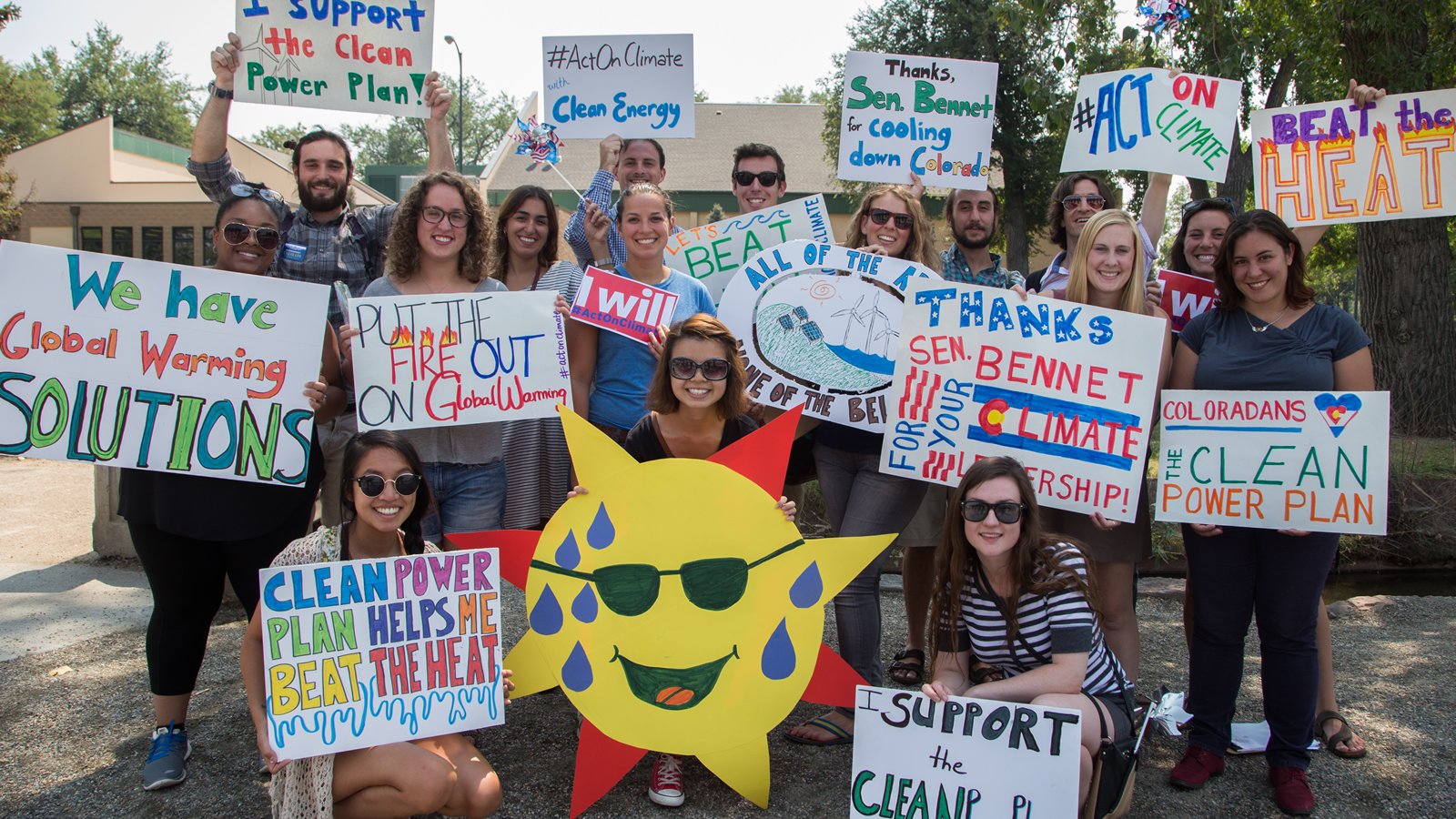
Environment America staff campaign in support of the Clean Power Plan in 2015. By Eliott Foust, Wefoust Photo

An attack on climate action repelled
We’ve seen it happen too many times: The oil industry draws on its deep reserve of lobbying money and blocks attempts to slow global warming.
In 2010, the industry is ready to pull out its playbook and reverse one of the biggest climate wins of the new century: California’s Global Warming Solutions Act. But this time, environmental advocates, including Environment California and CALPIRG, flip the script.
Act I: The Global Warming Solutions Act
Passed in 2006 with support from Environment California and CALPIRG, the Global Warming Solutions Act is the first in the nation to limit carbon and other climate-changing emissions economy-wide.
Four years later, clean energy use in California doubles, reducing the state’s carbon emissions and attracting $9 billion in clean technology investments.
Act II: Trouble comes to town
The oil industry, of course, is no fan of the act. Two Texas-based oil companies, Valero and Tesoro, launch a ballot initiative campaign to repeal the act on the November 2010 ballot.
The companies and their financial backers (including the Koch brothers) pour $10 million into Proposition 23, which, if approved by voters, would allow oil refineries and other polluters to put another 169 million tons of pollution into the air. Oil lobbyists write the text of the proposition; oil money pays for the signature-gathering required to put it on the ballot; and oil funds pay for the ads designed to persuade Californians to approve it.
However, something funny happens on the way to another defeat for outgunned environmentalists.
Act III: Californian chooses the climate
Together with an expansive coalition, Environment California and CALPIRG Students work to counter the industry’s advertising blitz, highlighting the Global Warming Solutions Act’s pollution cuts and positive economic impacts. The groups target young voters — the generation that will be most affected by climate change, and who overwhelmingly support clean energy and strong climate action.
Staff and student volunteers cover more than 40 college and university campuses across California, reaching half of the state’s students. A key partner in the effort is Van Jones of Green For All, who helps rally students at UC Berkeley alongside Environment California’s Dan Jacobson.
By Election Day, 1,000-plus volunteers hold more than 370,000 face-to-face conversations, gather more than 160,000 pledges to vote No on Prop. 23, and make 20,000 get-out-the-vote reminder calls.
Prop. 23 goes down in a landslide: 61% no to 39% yes, the largest margin for any of nine statewide ballot measures in 2010. It’s not just a win; it’s a statement: In California, climate action is here to stay.
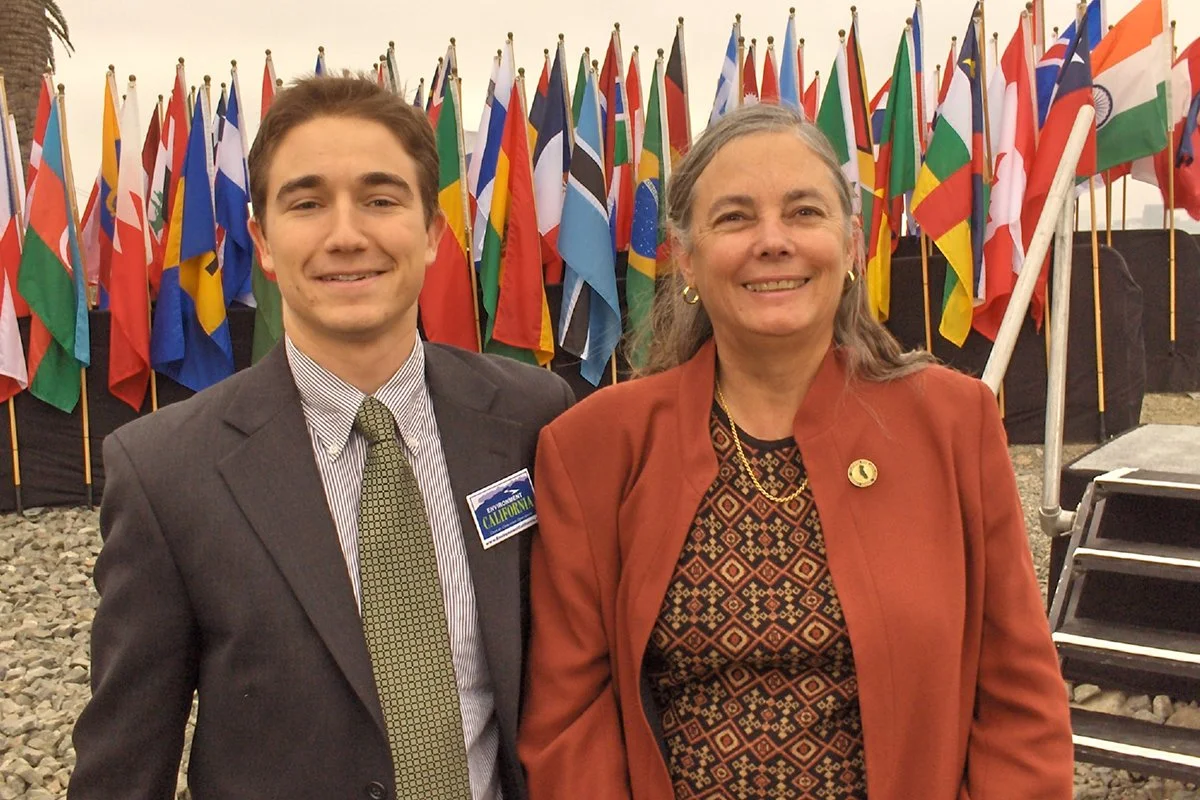
Environment California’s Jason Barbose with Assemblymember Fran Pavley at the signing of AB 32, the Global Warming Solutions Act in 2006. By staff

Van Jones speaks with Environment California’s Dan Jacobson and campaign staff during a training for the Prop 23 campaign in the fall of 2010. Photo by Susana Bates

Environment America staff and activists at the Climate March in New York City in 2014. Photo by staff


